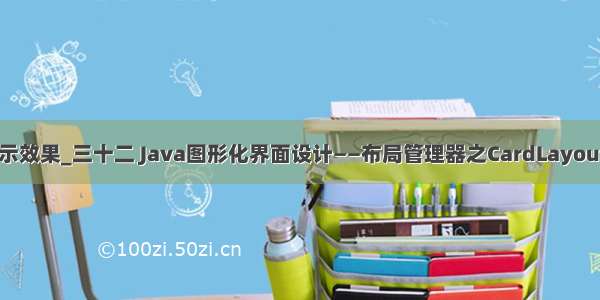
允许垂直或水平布置多个组件的布局管理器。这些组件将不包装,因此举例来说,垂直排列的组件在重新调整框架的大小时仍然被垂直排列。
用水平组件和垂直组件的不同组合嵌套多面板的作用类似于
GridBagLayout,但没那么复杂。该图显示了两个水平排列的面板,每个面板都包含 3 个垂直排列的组件。
BoxLayout 管理器是用 axis
参数构造的,该参数指定了将进行的布局类型。有四个选择:
X_AXIS:从左到右水平布置组件。
Y_AXIS:从上到下垂直布置组件。
LINE_AXIS:根据容器的ComponentOrientation属性,按照文字在一行中的排列方式布置组件。如果容器的ComponentOrientation表示水平,则将组件水平放置,否则将它们垂直放置。对于水平方向,如果容器的ComponentOrientation表示从左到右,则组件从左到右放置,否则将它们从右到左放置。对于垂直方向,组件总是从上到下放置的。
PAGE_AXIS:根据容器的ComponentOrientation属性,按照文本行在一页中的排列方式布置组件。如果容器的ComponentOrientation表示水平,则将组件垂直放置,否则将它们水平放置。对于水平方向,如果容器的ComponentOrientation表示从左到右,则组件从左到右放置,否则将它们从右到左放置。对于垂直方向,组件总是从上向下放置的。
对于所有方向,组件按照将它们添加到容器中的顺序排列。
BoxLayout
试图按照组件的首选宽度(对于水平布局)或首选高度(对于垂直布局)来排列它们。对于水平布局,如果并不是所有的组件都具有相同的高度,则
BoxLayout 会试图让所有组件都具有最高组件的高度。如果对于某一特定组件而言这是不可能的,则 BoxLayout 会根据该组件的
Y 调整值对它进行垂直调整。默认情况下,组件的 Y 调整值为 0.5,这意味着组件的垂直中心应该与其他 Y 调整值为 0.5
的组件的垂直中心具有相同 Y 坐标。
同样地,对于垂直布局,BoxLayout
试图让列中的所有组件具有最宽组件的宽度。如果这样做失败,则 BoxLayout 会根据这些组件的 X
调整值对它进行水平调整。对于PAGE_AXIS布局,基于组件的开始边水平调整。换句话说,如果容器的ComponentOrientation表示从左到右,则 X 调整值为 0.0
意味着组件的左边缘,否则它意味着组件的右边缘。
许多程序使用 Box 类,而不是直接使用
BoxLayout。Box 类是使用 BoxLayout 的轻量级容器。它还提供了一些帮助您很好地使用 BoxLayout
的便利方法。要获取您想要的排列,将组件添加到多个嵌套的 box 中是一种功能强大的方法。
如前所述,BoxLayout 可以把控件依次进行水平或者垂直排列布局,这是通过参数 X_AXIS、Y_AXIS
来决定的。X_AXIS 表示水平排列,而 Y_AXIS 表示垂直排列。BoxLayout 的构造函数有两个参数,一个参数定义使用该
BoxLayout 的容器,另一个参数是指定 BoxLayout 是采用水平还是垂直排列。下面是一个创建 BoxLayout
实例的例子:
JPanel panel=new JPanel();
BoxLayout layout=new BoxLayout(panel, BoxLayout.X_AXIS);
panel.setLayout(layoout);
在这个例子中,一个 BoxLayout 布局管理器的实例 layout 被创建,这个实例被设置为 panel
的布局管理器,该布局管理器采用了水平排列来排列控件。
当 BoxLayout
进行布局时,它将所有控件依次按照控件的优先尺寸按照顺序的进行水平或者垂直放置,假如布局的整个水平或者垂直空间的尺寸不能放下所有控件,那么
BoxLayout 会试图调整各个控件的大小来填充整个布局的水平或者垂直空间。
BoxLayout 往往和 Box 这个容器结合在一起使用,这么做的理由是,BoxLayout
是把控件以水平或者垂直的方向一个接一个的放置,如果要调整这些控件之间的空间,就会需要使用 Box
容器提供的透明的组件作为填充来填充控件之间的空间,从而达到调整控件之间的间隔空间的目的。Box 容器提供了 4 种透明的组件,分别是
rigid area、strut、glue、filler。Box
容器分别提供了不同的方法来创建这些组件。这四个组件的特点如下:
Rigid area 是一种用户可以定义水平和垂直尺寸的透明组件;
strut 与 rigid area
类似,但是用户只能定义一个方向的尺寸,即水平方向或者垂直方向,不能同时定义水平和垂直尺寸;
当用户将 glue 放在两个控件之间时,它会尽可能的占据两个控件之间的多余空间,从而将两个控件挤到两边;
Filler 是 Box 的内部类,它与 rigid area
相似,都可以指定水平或者垂直的尺寸,但是它可以设置最小,最大和优先尺寸。
在了解了 BoxLayout 和 Box 容器的基本特点后,我们来看一下 BoxLayout 的优点,首先 BoxLayout
可以进行对控件进行垂直或者水平布局,同时 BoxLayout 使用起来较为简单,然而把它和 Box
容器相结合,就可以进行较为复杂的布局,达到同使用 GridBagLayout
的一样的效果,但是使用起来要简单方便多了。我们用按钮的布局作为例子来看怎样运用 BoxLayout 和 Box 容器进行布局:
图 1. 应用 BoxLayout 进行按钮布局例子
1
我们在布局中经常会碰到如图 1 所示要把按钮放在容器的两端,那么我们就可以给容器定义一个 BoxLayout
来布局按钮,我们在按钮 1 和按钮 2 之间放置一个不可见的 glue,如前面所提到的那样,glue
就会尽量挤占掉两个按钮之间的空间,从而将两个按钮放在两端。
图 2. 应用 BoxLayout 进行按钮布局例子
2
再来看图 2 的例子,我们经常会遇到要将两个按钮放在容器的右边,我们就可以给容器定义一个 BoxLayout, 先放一个不可见的
glue,这个 glue 会挤占左边的空间,从而将两个按钮推到右边,
在两个按钮之间再放一个 strut,它也是不可见的,它会把两个按钮分隔开。
在基于前面讨论的基础上,我们现在来看一个具体的运用例子,假设图 3 是我们需要完成的用户界面:
图 3. BoxLayout
演示
这个演示是一个虚拟的用户对话框,只用于演示如何使用 BoxLayout,
例子代码中没有实现控件的动作。我们假定通过它用户可以选择要查询的运动会项目,然后查询,对话框中的表格显示了查询到的运动会项目的报名情况。为了完成这个布局,我们从上到下分别定义了
3 个 Panel, 分别叫做 topPanel,middlePanel,bottomPanel,这 3 个 Panel 都使用
BoxLayout。我们先看最上边的 topPanel,也就是包含表格的 Panel,topPanel 布局的基本思路是该 Panel
采用 BoxLayout 的垂直排列布局,先放置一个不可见的 Strut, 使topPanel 相
对顶部留出一定的空间,再放置包含表格的滚动窗格,再加入一个不可见的Strut,从而使topPanel和middlePanel之间留出一定的空间。TopPanel
的代码如清单 1 所示:
清单 1. topPanel
示例代码清单
static void createTopPanel() {
topPanel = new JPanel();
String[] columnName = { "姓名", "性别", "单位", "参加项目", "备注" };
String[][] rowData = { { "张三", "男", "计算机系", "100 米 ,200 米", "" },
{ "李四", "男", "化学系", "100 米,铅球", "" },
};
// 创建表格
JTable table = new JTable(new DefaultTableModel(rowData, columnName));
// 创建包含表格的滚动窗格
JScrollPane scrollPane = new JScrollPane(table);
scrollPane.setVerticalScrollBarPolicy(JScrollPane.VERTICAL_SCROLLBAR_ALWAYS);
// 定义 topPanel 的布局为 BoxLayout,BoxLayout 为垂直排列
topPanel.setLayout(new BoxLayout(topPanel, BoxLayout.Y_AXIS));
// 先加入一个不可见的 Strut,从而使 topPanel 对顶部留出一定的空间
topPanel.add(Box.createVerticalStrut(10));
// 加入包含表格的滚动窗格
topPanel.add(scrollPane);
// 再加入一个不可见的 Strut,从而使 topPanel 和 middlePanel 之间留出一定的空间
topPanel.add(Box.createVerticalStrut(10));
}
位于中间的 middlePanel 比较复杂些,它的左边包括标签运动会项目和运动会项目列表,中间是两个按钮,我们假定点击
>> 按钮将会把用户在运动会项目列表中选中的项目移到右边的查询项目列表,点击 <<
按钮则将右边查询项目列表中选中的项目移回到左边的运动会项目列表。它的布局的基本思路是定义了三个子 Panel,这三个子 Panel
分别对应最左边的标签和运动会项目列表,中间的两个按钮,和最右边的标签和查询项目列表,最左边的 Panel 采用 BoxLayout
的水平排列布局,中间的 Panel 采用 BoxLayout 的垂直排列布局,两个按钮之间加入一个不可见的
rigidArea,调整两个按钮之间的垂直距离,最右边的 Panel 采用 BoxLayout
的水平排列布局放置标签和查询项目列表。然后采用水平排列布局的 middlePanel 将三个 Panel 依次水平的加入。
MiddlePanel 的代码如清单 2 所示。
清单 2. middlePanel
示例代码清单
static void createMiddlePanel() {
// 创建 middlePanel
middlePanel = new JPanel();
// 采用水平布局
middlePanel .setLayout(new BoxLayout(middlePanel,BoxLayout.X_AXIS ));
// 创建标签运动会项目
JLabel sourceLabel = new JLabel("运动会项目:");
sourceLabel.setAlignmentY(Component.TOP_ALIGNMENT );
sourceLabel.setBorder(BorderFactory.createEmptyBorder (4, 5, 0, 5));
// 创建列表运动会项目
DefaultListModel listModel = new DefaultListModel();
listModel.addElement("100 米");
listModel.addElement("200 米");
listModel.addElement("400 米");
listModel.addElement("跳远");
listModel.addElement("跳高");
listModel.addElement("铅球");
JList sourceList = new JList(listModel);
sourceList.setSelectionMode(ListSelectionModel.MULTIPLE_INTERVAL_SELECTION );
sourceList.setVisibleRowCount(5);
JScrollPane sourceListScroller = new JScrollPane(sourceList);
sourceListScroller.setPreferredSize(new Dimension(120, 80));
sourceListScroller
.setVerticalScrollBarPolicy(JScrollPane.VERTICAL_SCROLLBAR_ALWAYS );
sourceListScroller.setAlignmentY(Component.TOP_ALIGNMENT );
// 创建最左边的 Panel
JPanel sourceListPanel = new JPanel();
// 最左边的 Panel 采用水平布局
sourceListPanel.setLayout(new BoxLayout(sourceListPanel,
BoxLayout.X_AXIS ));
// 加入标签到最左边的 Panel
sourceListPanel.add(sourceLabel);
// 加入列表运动会项目到最左边的 Panel
sourceListPanel.add(sourceListScroller);
sourceListPanel.setAlignmentY(Component.TOP_ALIGNMENT );
sourceListPanel.setBorder(BorderFactory.createEmptyBorder (0, 0, 0, 30));
// 将最左边的 Panel 加入到 middlePanel
middlePanel .add(sourceListPanel);
// 定义中间的两个按钮
JButton toTargetButton = new JButton(">>");
JButton toSourceButton = new JButton("<
// 定义中间的 Panel
JPanel buttonPanel = new JPanel();
// 中间的 Panel 采用水平布局
buttonPanel.setLayout(new BoxLayout(buttonPanel, BoxLayout.Y_AXIS ));
// 将按钮 >> 加入到中间的 Panel
buttonPanel.add(toTargetButton);
//两个按钮之间加入一个不可见的 rigidArea
buttonPanel.add(Box.createRigidArea (new Dimension(15, 15)));
// 将按钮 << 加入到中间的 Panel
buttonPanel.add(toSourceButton);
buttonPanel.setAlignmentY(Component.TOP_ALIGNMENT );
buttonPanel.setBorder(BorderFactory.createEmptyBorder (15, 5, 15, 5));
// 将中间的 Panel 加入到 middlePanel
middlePanel .add(buttonPanel);
// 创建标签查询项目
JLabel targetLabel = new JLabel("查询项目:");
targetLabel.setAlignmentY(Component.TOP_ALIGNMENT );
targetLabel.setBorder(BorderFactory.createEmptyBorder (4, 5, 0, 5));
// 创建列表查询项目
DefaultListModel targetListModel = new DefaultListModel();
targetListModel.addElement("100 米");
JList targetList = new JList(targetListModel);
targetList
.setSelectionMode(ListSelectionModel.MULTIPLE_INTERVAL_SELECTION );
targetList.setVisibleRowCount(5);
JScrollPane targetListScroller = new JScrollPane(targetList);
targetListScroller.setPreferredSize(new Dimension(120, 80));
targetListScroller
.setVerticalScrollBarPolicy(JScrollPane.VERTICAL_SCROLLBAR_ALWAYS );
targetListScroller.setAlignmentY(Component.TOP_ALIGNMENT );
// 创建最右边的 Panel
JPanel targetListPanel = new JPanel();
// 设置最右边的 Panel 为水平布局
targetListPanel.setLayout(new BoxLayout(targetListPanel,
BoxLayout.X_AXIS ));
// 将标签查询项目加到最右边的 Panel
targetListPanel.add(targetLabel);
// 将列表查询项目加到最右边的 Panel
targetListPanel.add(targetListScroller);
targetListPanel.setAlignmentY(Component.TOP_ALIGNMENT );
targetListPanel.setBorder(BorderFactory.createEmptyBorder (0, 30, 0, 0));
// 最后将最右边的 Panel 加入到 middlePanel
middlePanel .add(targetListPanel);
}
我们最后来看一下 bottomPanel 如何布局,bottomPanel 包括分布在两边的两个按钮,其实
bottomPanel 的布局和章节用 BoxLayout 进行布局中的图 1 是一致的,我们在两个按钮之间加入一个 glue, 这个
glue 会挤占两个按钮之间的空间,从而将两个按钮布局到两边,在 bottemPanel 中用一个 buttonPanel
来放置这两个按钮。BottomPanel 采用 BoxLayout, 首先放入一个 strut, 从而使 bottomPanel 和
middlePanel 之间留出距离,再放入 buttonPanel,再放入一个 strut, 从而使 bottomPanel
和底部之间留出距离,BottomPanel 的代码如清单 3 所示。
清单 3. bottomPanel
示例代码清单
static void createBottomPanel() {
// 创建查询按钮
JButton actionButton = new JButton("查询");
// 创建退出按钮
JButton closeButton = new JButton("退出");
// 创建 bottomPanel
bottomPanel = new JPanel();
// 设置 bottomPanel 为垂直布局
bottomPanel .setLayout(new BoxLayout(bottomPanel,BoxLayout.Y_AXIS ));
// 创建包含两个按钮的 buttonPanel
JPanel buttonPanel = new JPanel();
// 设置 bottomPanel 为水平布局
buttonPanel.setLayout(new BoxLayout(buttonPanel, BoxLayout.X_AXIS ));
// 将查询按钮加入到 buttonPanel
buttonPanel.add(actionButton);
//加入一个 glue, glue 会挤占两个按钮之间的空间
buttonPanel.add(Box.createHorizontalGlue ());
// 将退出按钮加入到 buttonPanel
buttonPanel.add(closeButton);
// 加入一个 Strut,从而使 bottomPanel 和 middlePanel 上下之间留出距离
bottomPanel .add(Box.createVerticalStrut (10));
// 加入 buttonPanel
bottomPanel .add(buttonPanel);
// 加入一个 Strut,从而使 bottomPanel 和底部之间留出距离
bottomPanel .add(Box.createVerticalStrut (10));
}
我们用一个 Panel 来从上到下放置 topPanel、middlePanel 和 bottomPanel,这个 Panel
采用了 GridBagLayout, 最后我们将这个 Panel 加到一个窗体中去,请参考清单 4。
清单 4.
创建窗体示例代码清单
public static void main(String[] args) {
// 创建 topPanel
createTopPanel ();
// 创建 middlePanel
createMiddlePanel ();
// 创建 bottomPanel
createBottomPanel ();
// 创建包含 topPanel,middlePanel 和 bottomPanel 的 panelContainer
JPanel panelContainer = new Jpanel();
//panelContainer 的布局为 GridBagLayout
panelContainer.setLayout(new GridBagLayout());
GridBagConstraints c1 = new GridBagConstraints();
c1.gridx = 0;
c1.gridy = 0;
c1.weightx = 1.0;
c1.weighty = 1.0;
c1.fill = GridBagConstraints.BOTH ;
// 加入 topPanel
panelContainer.add(topPanel,c1);
GridBagConstraints c2 = new GridBagConstraints();
c2.gridx = 0;
c2.gridy = 1;
c2.weightx = 1.0;
c2.weighty = 0;
c2.fill = GridBagConstraints.HORIZONTAL ;
// 加入 middlePanel
panelContainer.add(middlePanel,c2);
GridBagConstraints c3 = new GridBagConstraints();
c3.gridx = 0;
c3.gridy = 2;
c3.weightx = 1.0;
c3.weighty = 0;
c3.fill = GridBagConstraints.HORIZONTAL ;
// 加入 bottomPanel
panelContainer.add(bottomPanel,c3);
// 创建窗体
JFrame frame = new JFrame("Boxlayout 演示");
frame.setDefaultCloseOperation(JFrame.EXIT_ON_CLOSE );
panelContainer.setOpaque(true);
frame.setSize(new Dimension(480, 320));
frame.setContentPane(panelContainer);
frame.setVisible(true);
}
本文的例子是在文件 BoxLayoutDemo.zip 中,您将其展开,导入到 Eclipse 中去,就可运行例子。
















